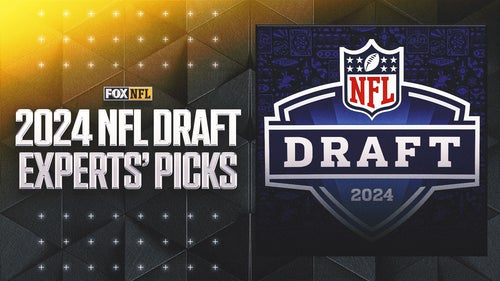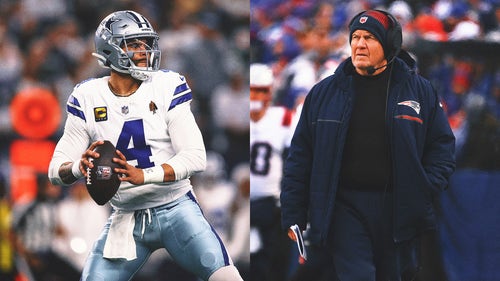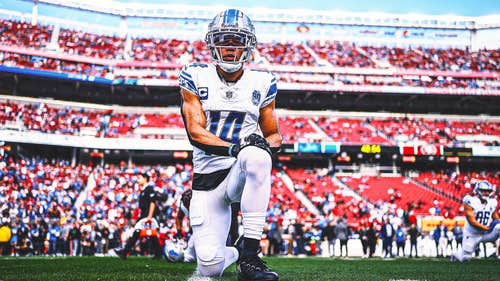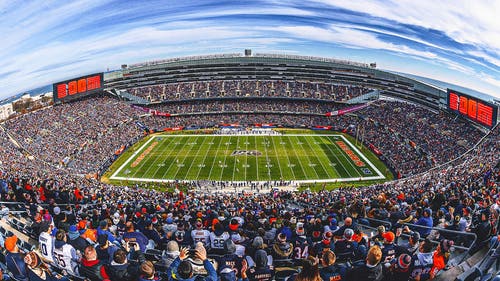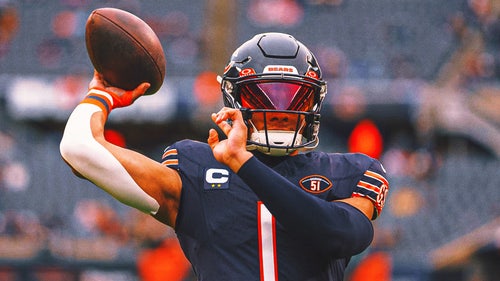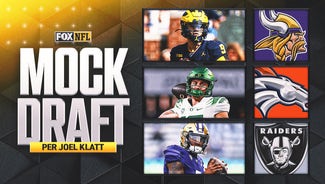
2010 NFL Draft grades
Arizona: Some thought the Cardinals would pursue a quarterback in this draft, but they passed on some big names and ended up taking strong-armed John Skeleton of Fordham in the fifth round. Tennessee DT Dan Williams fell into their lap in the first round and he should be the nose tackle this 3-4 defense needs. They traded with the Patriots to take TCU OLB Darrell Washington, who had 39 reps of 225 pounds at the Combine and was once considered a possible first-round pick by the Jets. Washington had a super senior season at TCU and maybe he replaces Karlos Dansby as a playmaker — great value with the 47th overall pick in Washington. Wisconsin pass rusher O’Brien Schofield will start training camp on the physically unable to perform list after tearing his ACL at the Senior Bowl, but he has tremendous upside when healthy. Not a need position, but Schofield, who was the MVP of the East-West game, was good value. Grade: B
Atlanta: The Falcons concentrated on filling needs with Missouri OLB Sean Weatherspoon, possibly the most complete linebacker in the draft. He can cover and also rush the passer. To beef up the defensive line, Kentucky DT Corey Peters was taken with the 83rd overall pick and he should be a run stuffer. Alabama guard Mike Johnson is a physical run blocker and gives the Falcons some much needed depth at the position. Johnson started 41 consecutive games and played in a school-record 54 games. You have to remember, too, that the Falcons used a second-round pick on Tony Gonzalez, who paid huge dividends last season to Matt Ryan and the offense. Weatherspoon should be a starter. Guard Joe Hawley provided much-need depth. Oklahoma CB Dominique Franks knows how to play, but does he possess NFL speed and quickness? Grade: B
Baltimore: GM Ozzie Newsome made all the right moves on the first two days of the draft, trading out of the first round and getting two quality defensive players with first-round grades in Texas linebacker Sergio Kindle of Texas and massive Alabama nose tackle Terrence Cody with the 57th overall pick. Kindle was downgraded by some teams out of the first round because of a knee injury, but he’s a fast, explosive outside linebacker and should fit well in Baltimore’s defensive scheme. Cody has struggled with his weight (he’s listed at 350 pounds), but Newsome feels that he has a relationship with the fellow Alabama grad and can get this guy under control. The addition of Cody means that few teams will be able to move the Baltimore middle. Syracuse DE Arthur Jones was a super value pick. Baltimore added to their receiving corps with Utah’s David Reed, who has excellent hands and is quick out of the break. Grade: B+
Buffalo: The Bills passed on their quarterback needs (maybe Trent Edwards is better than we think?), but they took the draft’s best running back, Clemson’s C.J. Spiller, who is a home-run hitter. To shore up their porous run defense, they grabbed 318-pound nose tackle Torrell Troup of Central Florida about 20 spots too high. Troup was a three-year starter and a team captain and ran a spectacular 5.1 40-yard dash. Arkansas State DE Alex Carrington should fit ideally into the 3-4 scheme. Surprisingly, the trade rumors were false on Marshawn Lynch, meaning that he and Spiller could be in the same backfield, which should pose problems for opposing defenses. Troy QB Levi Brown was an interesting pick late, but Coach Chan Gailey apparently likes ex-Packer Brian Brohm, too. Grade: C
Panthers: On paper, if this is GM Marty Hurney’s final draft with the Panthers, it has a chance to be his best. Hurney didn’t have a first-round pick and he tried to trade up with the Rams in order to select Notre Dame QB Jimmy Clausen, but got him anyway with the 48th overall pick in the second round. Clausen should give Matt Moore a run for his money sometime this season as the starter. With Carolina’s great running game, Clausen has excellent deep-ball accuracy. Remember, the Panthers traded away their first-round pick last year to San Francisco in order to draft Everette Brown, who had 15 tackles and 2 1/2 sacks last season. To help Moore and Claussen, the Panthers got two potential playmakers in Armanti Edwards and Brandon LaFell. Edwards was the quarterback at Appalachian State where he won two national titles, but he projects as a receiver and maybe even a wildcat quarterback. LaFell had a rough senior season at LSU and ran a poor 4.62 at the Combine, but he finished with 175 receptions for 25 TDs. The only bad thing was that Hurney traded away next year’s second-round pick to the Patriots to get this done. OLB Eric Norwood was also good value in the fourth round. Cincinnati QB Tony Pike was an interesting pick. Grade: A+
Chicago: The Bears did pretty well, considering they didn’t select until the 75th pick when they got tremendous value in safety Major Wright. The former Florida Gator draws immediate comparisons to the once-great Mike Brown, who suffered too many injuries in his short Chicago career. The Bears have had 21 different safeties since Lovie Smith took over and the hope is that Wright will be a mainstay. Northwestern’s Corey Wooten had a chance to be a high pick this year until he had knee surgery, but he should develop into a great edge rusher. Considering their limited draft location, the Bears did well but GM Jerry Angelo made a critical mistake in not trading into the top of the round for an offensive tackle. Remember, the Bears have made so many personnel moves this off-season (Julius Peppers, Chester Taylor) to win this season. Central Michigan’s Dan LeFevour has the smarts and feet to develop into a backup quarterback. He needs to improve his throwing accuracy. Grade: C
Cincinnati: Bengals QB Carson Palmer will be excited with Oklahoma TE Jermaine Gresham who can stretch the field and has been given a clean bill of health after missing all of last season with a knee injury. Most mock drafts had Gresham landing here. The Bengals typically select some risky players, but they claim that Carlos Dunlap’s DUI charge prior to the SEC championship game was an aberration. Dunlap was a great pass rusher at Florida and he has drawn comparisons to Julius Peppers because he’s 6-6 and 277 pounds and very athletic. His nickname was “Baby Freak” because he drew comparisons to former Gator Jevon Kearse. Dunlap had 26 tackles for losses and 19 1/2 sacks in his three-year career. Texas WR Jordan Shipley was very productive in college with at least six games with 10 or more catches. He’s a physical, deep-threat receiver. Wake Forest CB Brandon Ghee has been compared favorably to current Bengals starter Johnathan Joseph. Ghee started 33 games, but came up with only one interception. The steal of their draft could be WR Dezmon Briscoe of Kansas who ran poorly at the Combine and has some off-the-field issues but once was considered just a step behind Dez Bryant in the Big 12 Conference. Grade: B.
Cleveland: For an offensive president, Mike Holmgren listened to his coaches and scouts and picked two secondary players with his first two picks. Cornerback Joe Haden started 40 games for Florida and finished with 157 tackles and 8 interceptions. They didn’t reach on him. T.J. Ward of Oregon is a hitter, but he didn’t have many interceptions in college and some had him rated as a fourth-round pick. Montario Hardesty was a great north-south runner at Tennessee, but can he juke and change direction in the lane? Hardesty is a banger and Holmgren thinks his running style will prove valuable in bad winter weather. But the key to the draft was the selection of Texas QB Colt McCoy with the 85th overall pick. McCoy won 45 games in 53 college starts. McCoy made perfect sense in the third round and he will be given every opportunity to be the future quarterback of this struggling franchise. Holmgren did say that he won’t be coaching McCoy, nor will the rookie play this season. It’s Jake Delhomme’s job in 2010. Grade: B+
Dallas: With the uneven play of Roy Williams, owner Jerry Jones wanted a playmaker opposite Miles Austin and he moved up in the draft to get Oklahoma State’s Dez Bryant, who will wear Michael Irvin’s No. 88 jersey. Bryant’s upbringing and the fact that he lied to NCAA investigators about his involvement with Deion Sanders got him suspended troubled some teams, but not the Cowboys, who will build a support system around him. Jones claims that he won’t trade Williams or Patrick Crayton to make Bryant’s transition easier. Penn State’s Sean Lee was the most instinctive linebacker in college football last season and the only concern about him is if he can keep himself healthy. Several teams wanted Lee, but the Eagles traded a pick with Jones in order for him to become a Cowboy. Akwasi Owusu-Ansah is a big, athletic cornerback from tiny Indiana (Pa.) State. He’s coming off an injury, but he’s expected to be ready for training camp. The Cowboys didn’t address their needs on the offensive line, but there are big hopes that either Doug Free or Robert Brewster, a third-round pick last year, will fill Flozell Adams’ spot at left tackle. Grade: B
Denver: Yes, there have been many snickers around the NFL about coach Josh McDaniels being immature (Chargers incident last season) and still learning on game days. But he’s turned into one trading Jessie on draft day. He and GM Brian Xander left the first round with two selections and the two players they wanted in WR Demaryius Thomas and QB Tim Tebow, who should compete with Kyle Orton for the starting job. Unlike Brandon Marshall and Jay Cutler, these two players are saints and definitely hard-workers. Zane Beadles played left tackle at Utah, but is projected inside as a guard and was a solid pick in the middle of the second round. Minnesota receiver Eric Decker was a one-man show in college and a lot of teams loved him in the second round until a foot injury sidelined him. Decker played all four seasons at Minnesota and finished with 227 catches for 3,119 yards and 24 TDs. Cal CB Syd’quan Thompson projects to be a physical, tough zone player and should make the team despite being a seventh-rounder. McDaniels eventually took a risky pick in Oklahoma State CB Perrish Cox, who was suspended at the end of the season, but he could turn into a top-flight player and returner. Grade: B+
Detroit: GM Martin Mayhew learned under former boss Matt Millen and he’s responded by being more aggressive and also selecting quality. The Lions wanted Cal running back Jahvid Best in the second round, but got fearful and traded into the bottom of the first round to make sure they grabbed the complimentary runner to Kevin Smith. DT Ndamukong Suh was the top-rated player in the draft and he went second overall simply because the Rams had to take a quarterback. Iowa CB Amari Spievey was a ballhawk in college and the Lions need him to produce. Miami OT Jason Fox will be given every opportunity to make the lineup. Nate Burleson was a quality addition in the offseason, too, but he won’t have to contend with Mr. Irrelevant, Weber State receiver Tim Toone, the last player taken in the draft. Toone is 5-11 with 4.55 speed. Grade: B
Green Bay: The Packers got great value with their first pick, Iowa OT Bryan Bulaga, who has a chance to start as a rookie at right tackle. Georgia Tech safety Morgan Burnett gives the Packers some depth at safety where Atari Bigby has had injury concerns. Mike Neal is really strong and spent five years at Purdue, starting as a defensive end and then switching to defensive tackle. His first love was basketball, but he will play end in the 3-4 defense. He had 26 tackles for a loss and 13 sacks at Purdue. The best news about the team’s top three picks is that all are solid citizens with no injury history. TE Andrew Quarless spent a lot of time in Joe Paterno’s doghouse at Penn State, but he did have 41 catches last season and could be a deep threat for Aaron Rodgers. RB James Stark missed his entire senior season at Buffalo, but if he plays to his old level could prove to be a valuable addition. Grade: C
Houston: The Texans shocked most scouts by taking Alabama CB Kareem Jackson over Kyle Wilson, but they believe Jackson is more versatile and can play press and also fill the nickel role. Auburn RB Ben Tate (5-11, 220 pounds) is a powerful back with no durability issues, plus he ran 4.34 and had a spectacular workout at the Combine. They took a high motor defensive lineman in Earl Mitchell of Arizona who lacks size and may be a situational defender. Wisconsin TE Garrett Graham is solid insurance, considering Owen Daniels’ injury history. Miami (Fla.) LB Darryl Sharpton is an instinctive player and he should help on special teams right away and could force his way into the lineup. They added another tight end in Pitt’s Dorin Dickerson, who caught 10 touchdowns last season. Dickerson was ranked as a top-100 player, but he fell to the 227th pick for some reason. Maybe it’s because he’s not a good blocker and more of a receiver than a tight end? Grade: C
Indianapolis: Bill Polian said he wanted defense in this draft and he went out and did exactly that. TCU pass rusher Jerry Hughes fits the Dwight Freeney mold and should help immediately in the rotation. Iowa MLB Pat Angerer has the right name for a football player and should back up Gary Brackett. He’s a very instinctive player and was highly productive in college. USC’s Kevin Thomas has played against some of the best in the Pac-10 and fits the Indy mold. Oklahoma’s Brody Elridge (6-5, 261) was the best blocking tight end in the draft and fills a short-yardage need. Tennessee OG Jacques McClendon gives the team some depth on what is a questionable offensive line. Grade: B
Jacksonville: The Jaguars had only 14 sacks last season and that’s why they focused on defensive linemen and pass rushers in this draft. However, they should have traded down to get Cal’s Tyson Alualu instead of picking him with the 10th overall selection. Maybe the 49ers would have made that trade for their 17th overall pick? The draft consensus is that Alualu ranked between 25 and 40 on the majority of team’s draft boards. The Jaguars must be faulted for not knowing the value of their first pick. Larry Hart, a defensive end from Central Arkansas, has a chance to be special. Austen Lee and D’Anthony Smith are rangy, athletic pass rushers. Scotty McGee of Murray State has 4.37 speed and should upgrade the return game. One good move was adding linebacker Kirk Morrison, who has led the Raiders in tackles for five straight seasons. Grade: C-
Kansas City: Former NFL coach Monte Kiffin says that Tennessee safety Eric Berry is ready to play right away on the pro level and destined to be a star. Berry likes to think of himself as the next Ronnie Lott. Dexter McCluster, Ole Miss, could be the slot receiver that Matt Cassel had in Wes Welker when with the Patriots. Many compare McCluster to Darren Sproles or former Giants Dave Meggett when gauging his versatility. And with the pick for Tony Gonzalez, the Chiefs took Javier Arenas of Alabama, who may be the best returner in the draft. He’s only 5-8, but he made a lot of plays for the Tide off the edge. The first three picks all came from the SEC. Free safety Kendrick Lewis plays better than he ran at the Combine and is a classic overachiever and high character player. Grade: B
Miami: The Dolphins took advantage of their work at the Senior Bowl by drafting a lot of players they coached there, plus they moved down in the first round, saving some money in order to pay new receiver Brandon Marshall. First pick Jared Odrick of Penn State fits their defensive scheme in the 3-4 and Utah outside linebacker Koa Misi is a pass-rush specialist and a hard-nosed player. The Dolphins have already said that DE Randy Starks will be moved to nose tackle in order to make room for Odrick and Misi on the outside. Ole Miss OT John Jerry, whose brother Peria plays for the Falcons, will slide down to guard where his powerful leverage and quickness should be better suited. Grade: A
Minnesota: The Vikings tried to trade back into the first round for Boise State CB Kyle Wilson because cornerback was a need. They ended up with Virginia’s Chris Cook, who ran a 4.49 at the combine. This position was a need because the Vikings probably won’t have Cedric Griffin for the start of the season, plus veteran Antoine Winfield missed six games last season and will be 33 this season. In a trade with the Texans, the Vikings took Stanford RB Toby Gerhart, who rushed for 1,871 yards and 28 touchdowns last season. He was Jimmy Johnson’s favorite college player. Gerhart should be able to spell Adrian Peterson and keep the offense moving. USC pass rusher Everson Griffin was a top-25 talent in the fourth round while Minnesota LB Nathan Triplett gives them some insurance in case E.J. Henderson doesn’t fully recover. Grade: C+
New England: No one understands the NFL trading game better than Bill Belichick, who moved around in this draft and left it with two first-round and two second-round picks for 2011. This is great news because those picks could be extremely valuable if the league institutes a rookie salary cap. New England’s first two picks, Rutgers CB Devin McCourty, and Arizona TE Rob Gronkowski, were need picks. The Pats really don’t have a tight end after losing Ben Watson. Gronkowski missed the entire 2009 season with a back injury, but Tom Brady should find him down the seam because he is 6-6, 265 pounds. He averaged 18.1 yards a catch. Florida LB Brandon Spikes is an old-school middle linebacker who has superior instincts and probably is a better all-around player than DE Jermaine Cunningham who was taken nine picks ahead of him. In the fifth round, the Pats took punter Zoltan Mesko of Michigan and he figures to make the team. Grade: B+
New Orleans: Starting offensive tackle Jamaal Brown, who will be an unrestricted free-agent in 2011, wasn’t happy with the selection of USC Charles Brown in the second round. Brown is a left tackle and he was value pickup late in the second round because he appeared in the first round on some mock drafts. LSU defensive tackle Al Woods needs to work his double-team moves, but he did have a 37-inch vertical jump for a huge man. Woods fills a defensive need. Miami TE Jimmy Graham is the perfect Sean Payton pick because he’s a project after playing only one season of college ball. First pick Patrick Robinson of Florida State suits the Saints’ style of defense; he can play zone coverage or press coverage on the outside. Robinson gives this team necessary depth, considering how much they love to blitz. Boston College center Matt Tennant adds depth while Oregon State QB Sean Canfield may push aging Mark Brunell. Grade: C
New York Giants: The Giants wanted Alabama MLB Rolando McClain, but they might have lucked out with Phillip Dillard with the 115th pick. Dillard was a solid middle linebacker at Nebraska and played super at the end of the season for the Cornhuskers. Before that, the Giants risked their first-round pick on South Florida pass rusher Jason Pierre-Paul, who is physically gifted but short on football experience. NT Linval Joseph battled weight issues (up to 370 pounds) at East Carolina, but he’s a powerful player who has a chance to anchor the defensive line. LSU safety Chad Jones played in the outfield for the Tigers’ national championship team and the Giants love his hands and 6-2, 220-pound frame. With 44-year-old Jeff Feagles entering his 23rd NFL season, the Giants took East Carolina punter Matt Dodge in the fifth round. Grade: B-
New York Jets: They fell into one of the draft’s best cover cornerbacks in Kyle Wilson of Boise State at the bottom of the first round. Wilson could end up teaming with Darrelle Revis. OT Vladimir Ducasse moved here in 2002 from Haiti and only played two years of high school football, but he started three years at Massachusetts and was all-league twice. Ducasse is a great project because he’s 6-4, 332 pounds with 35-inch arms. USC running back Joe McKnight was great value in the fourth round. His style suits the pro game because he can catch and also return kicks. The key is whether McKnight is as productive as Leon Washington, who was traded to Seattle. They added a solid fullback blocker in Kentucky’s John Conner, a 246-pounder. They also unloaded veteran guard John Faneca because he was guaranteed more than $5 million this season. Grade: B
Oakland: Owner Al Davis lit a bonfire under JaMarcus Russell with the acquisition of Redskins QB Jason Campbell for a 2012 fourth-round pick. Campbell is a deep-ball thrower that Davis has always loved. Russell is due over $9 million this season and I can see the Raiders asking him to take a $7 million pay reduction; if they release him, who would take him? Davis finally went against his size and speed measurements and simply took a quality football player in MLB Rolando McClain, the defensive leader of Alabama’s national championship team. Lamarr Houston was a high school running back who ballooned into a very good defensive tackle at Texas. He should be a great one-gap penetrator. Finally, the Raiders took Maryland OT Bruce Campbell, the athletic phenom (4.84 for 314-pounder) at the Combine, who simply needs to listen to head coach Tom Cable to learn how to play a little tougher and stronger. Campbell had a low second-round grade, so it was a great selection. Clemson WR Jacoby Ford has 4.28 speed and should be a playmaker. To get Ford, Davis traded starting MLB Kirk Morrison to the Jaguars, opening up the position for McClain. Grade: A+
Philadelphia: The Eagles gave up a lot to move up in the first round to take Michigan pass rusher Brandon Graham, who was a dominant performer in the Big Ten. Andy Reid is hoping that second-round pick Nate Allen of South Florida can shore up the safety position, but he’s not an intimidator like Brian Dawkins was for this franchise. Allen is also going to be remembered as the Donovan McNabb selection, too. A lot of pressure on this kid to produce. For all their ammunition prior to the draft, the Eagles kind of struck out. With the 122nd pick, the Eagles surprised many by taking Northwestern QB Mike Kafka over Tony Pike and Dan LeFevour. Obviously, Kafka is smart but his arm seemed limited. The Eagles did a lot better in the later rounds on value, getting Clemson OLB Ricky Sapp, who had second-round grades, Florida receiver Riley Cooper who should be a big target in the red zone and H-back Clay Harbor of Missouri State. Ohio State safety Kurt Coleman was a playmaker and has a shot to make the team from the seventh round. Grade: B-
Pittsburgh: There were phony rumors out there that Ben Roethlisberger was on the trading block, so the Steelers focused on shoring up the offensive line with Florida center Maurkice Pouncey, who was their target from the outset. Virgina Tech OLB Jason Worilds ideally suits the Steelers’ 3-4 scheme as an edge rusher and may remind some of James Harrison. Former Ohio State standout Thaddeus Gibson is a great athlete who was only a one-year starter and he was something of tweener at OLB and defensive end. He’s a project. SMU WR Emmanuel Sanders will try to fill Santonio Holmes’ shoes. RB Johnathan Dwyer of Georgia Tech was considered a second-round pick, but fell to the sixth round because of a failed drug test for amphetamines for medical reasons at the Combine. Dwyer was off some teams’ draft boards. Grade: B+
San Diego: The entire draft for the Chargers will be based on what kind of impact Fresno State running back Ryan Mathews makes this season. The Chargers gave up their 40th pick to move up in the first round and take Mathews, who was considered the draft’s best all-around runner. Coach Norv Turner now has the big back to work with Darren Sproles. Washington linebacker Donald Butler can play inside and outside and is super smart. North Carolina’s Cam Thomas (330 pounds) will be given every chance to win the starting nose tackle spot while the Chargers actually took a quarterback in Jonathan Compton, who passed for 27 touchdowns and 13 INTs last season with Tennessee. Grade: C
San Francisco: The 49ers bolstered their offensive line and didn’t take a quarterback, meaning they will stick with Alex Smith this season. Anthony Davis of Rutgers will be given every chance to start at right tackle this season while Idaho guard Mike Iupati is a tremendous run blocker with a nasty streak. These two players will allow the 49ers to pound the ball while also providing Smith with better pocket protection. Free safety Taylor Mays of USC was considered a top ten pick a year ago, but he slipped this season because he didn’t track the deep ball very well and missed so many interception opportunities. But Mays can run and tackle and should be a good fit. He is motivated to prove his worth, too. Mississippi State RB Anthony Dixon was a one-man offense in college and is a good fit behind Frank Gore. LB Navorro Bowman played well at Penn State, but his draft stock fell because of some off-the-field issues. Grade: A
Seattle: Despite former player Taylor Mays taking a personal shot at his former coach, Pete Carroll, the former USC coach had a great three-day draft. The Seahawks got a great playmaker in Texas safety Earl Thomas, who was coveted by coordinator Gus Bradley. And OT Russell Okung was the top-rated tackle on the majority of teams’ boards and was available because the Redskins prefer a zone-blocking scheme and wanted a more athletic tackle in Trent Williams. They spent the 40th pick on Chargers QB Charlie Whitehurst. They needed a receiver and got Golden Tate, who had a great final season at Notre Dame with 93 catches for 1,496 yards and 15 touchdowns before going to play center field for the baseball team. They tried to trade for Marshawn Lynch, but ended up with ex-Trojan in LenDale White in a deal with the Titans. White gives them a power running back to go with Justin Forsett, considering how disappointing Julius Jones has been. But the best news was the acquisition of Leon Washington from the Jets, meaning that Jones might be an afterthought as a starter. Tate should be a return man. Carroll took a chance on his former player, Anthony McCoy, who tested positive for marijuana at the Combine. McCoy was hampered by an ankle injury last season. Grade: A+
St. Louis: This team, regardless of who the owner is, had no other choice but to draft a quarterback and hope that Sam Bradford does become the successful new face of the franchise. There should be no threat of a holdout because CEO Kevin Demoff has done four big contracts with agents Tom Condon/Ben Dogra over the past six seasons. Indiana OT Rodger Saffold, a three-year starter, had first-round grades by at least a dozen teams and this was another huge need. Marty Gilyard was an explosive receiver at Cincinnati and he should be the starting kick returner, too. DE George Selvie lost his starting job at South Florida to the Giants’ first-round pick, Pierre-Paul, but he did have an awesome sophomore season and Penn State linebacker Josh Hull was a solid pick in the seventh round. There seemed to be 30 tight ends taken in this draft and the Rams took two of them in Michael Hoomanawanui of Illinois (the blocker) and Fendi Onobun of Arizona (the vertical threat). Grade: B
Tampa Bay: Maybe they had Ndamukong Suh rated higher than Gerald McCoy, but this Oklahoma tackle will be an instant starter and bring energy and pass-rush ability. The Bucs followed that with another DT in UCLA’s Brian Price, a great three-technique rusher while ignoring a chance to take a receiver. But they got quality at that position with Arrelious Benn of Illinois because he entered the 2009 season as a top ten pick but suffered an ankle injury and struggled because of the horrible Illinois quarterback situation. Syracuse WR Mike Williams got suspended last season, but most teams had a second-round grade on him, so he was a bargain in the fourth round. I don’t know if Cody Grimm can hold up in the NFL, but the Virginia Tech safety forced eight fumbles last season and is a high-energy guy. Grade: A
Tennessee: Having lost Kyle Vanden Bosch to the Lions in free-agency, the Titans fell into one of the draft’s most complete defensive ends in Georgia Tech’s Derrick Morgan in the first round. Most teams had Morgan as a top ten pick. USC receiver Damian Williams returned two punts for touchdowns last season and the Titans have a definite need in that area. Williams was also a productive receiver with 70 catches for 1,010 yards and six touchdowns. He finished is career with 17 TDs. Rennie Curran was a tackling machine at Georgia with 130 tackles in his senior season. The only knock on the 235-pound Curran is that he’s only 5-10. Curran was also a team captain and started 25 games in his last two seasons. The Titans took the smartest player in the draft in former Florida State safety Myron Rolle, who spent last season as a Rhodes Scholar at Oxford. Rolle hopes to one day to become a surgeon. Grade: B
Washington: The only way to look at their draft is that Mike Shanahan gave up a second-round pick for Donovan McNabb, a veteran QB that he loves. OT Trent Williams will be an instant starter and his athletic style suits Washington’s zone-blocking run scheme. LSU linebacker Perry Riley fills a need. The only bad thing is that the Redskins couldn’t get better compensation (2012 fourth-round pick) for Jason Campbell in the trade with the Raiders. Grade: C






































































































































